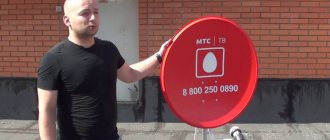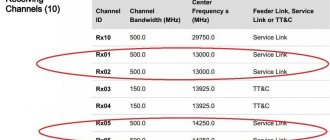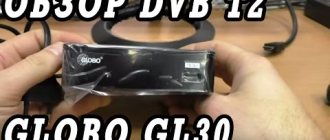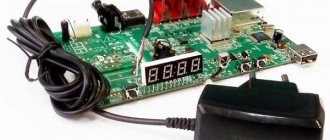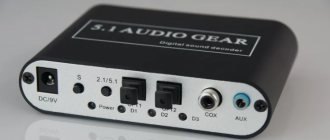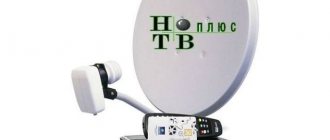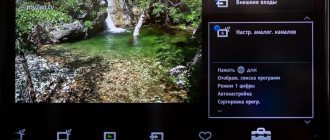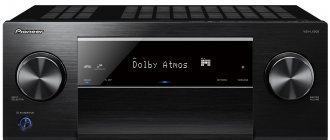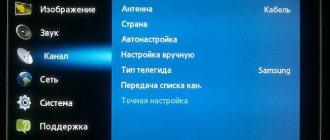| Frequency, MHz | S.R. | Polar. | FEC |
| 11505 | 3400 | V | 7/8 |
| 11605 | 43200 | V | 7/8 |
| 11105 | 43200 | H | 5/6 |
| 11793 | 43200 | V | 5/6 |
| 11531 | 22000 | V | 2/3 |
| 11733 | 43000 | V | 5/6 |
| 11665 | 44922 | V | 5/6 |
| 11045 | 44922 | H | 5/6 |
| 11559 | 22000 | V | 5/6 |
ABS2 transponder frequencies - DVB-S2 standard
| Frequency, MHz | S.R. | Polar. | FEC |
| 11473 | 22500 | V | 3/4 |
| 10985 | 35007 | H | 3/4 |
| 11491 | 4650 | V | 2/3 |
I suggest you read an article about where to watch frequency updates and how to use satellite television frequency tables.
Step-by-step setup of the receiver for Rainbow TV
We have received the data, we are more or less savvy in theory, let’s proceed to step-by-step setup of the receiver on ABS2. I will explain setting up the receiver using the example of a fairly common receiver, at least in our region, GI-S 1025. If you have a different receiver model, don’t be upset, the essence is about the same.
First, let's delete old data. It is advisable to make the settings slowly, so as not to press just anyone, anywhere. If we rush, we can mess up important receiver settings. However, this too can be fixed. At the end of the article, as I promised, we will consider the options why, after setting up the receiver for Rainbow TV, it does not work.
Press the MENU button on the receiver's remote control, in the window that opens, select System and press OK.
Next, in the window that opens, select Factory settings, and OK.
In the next window, select Delete all channels and OK.
A question will appear on the TV screen: Are you sure you want to delete all channels? And the options for action are Yes and No. Select Yes and confirm the action by pressing the OK button.
Next, press the EXIT button several times until we exit the settings.
So. We have deleted the channels. The TV screen displays the message no channels. Now we need to remove the transponders of the old Raduga TV satellite, and register the frequencies and other parameters of the transponders of the ABS2 satellite.
Click on MENU again, then select Installation, and OK.
In the window that opens, select Install again, and OK.
The following window will open in front of us.
The satellite name should be displayed as ABS1_KU 75E. The name itself tells us that the satellite’s transponders operate in the Ku-band, and the satellite itself is located in geostationary orbit at a position of 75 degrees east longitude. This is our satellite.
If, when opening the window, the name of another satellite is displayed, scroll through the satellites and find the one you are interested in. In some cases, our satellite may be named in the settings as LMI1_KU 75E, everything is fine, this is the old name of the satellite.
If you wish, you can edit the name of the satellite, I do not do this. The name of the satellite does not in any way affect the correct settings of the receiver.
Below on the TV screen, in the window we open, colored buttons with tips are displayed. We are interested in the yellow button labeled as TP edit, i.e. editing transponders.
Press the yellow button on the receiver remote control once.
Now, in a new window that opens, the yellow button performs the functions of deleting transponders. Let's start removing the transponders of the old satellite.
Press the yellow button once, the screen displays the message “Are you sure you want to delete?”, confirm your action with the OK button. So, until we delete the entire list of old frequencies. Or press the blue button and delete the entire list of transponders at once.
Next, when there is nothing more to delete, click once on the green button labeled Add.
A window appears in which we need to enter the parameters of one of the transponders of the ABS2 satellite. So, one by one you can add the entire list of transponders of the new Rainbow TV satellite. But as a rule, all receivers are smart; just one is enough. I usually enter one, this one.
| Frequency, MHz | S.R. | Polar. | FEC |
| 1154511605 | 43200 | V | 7/8 |
After we have entered the transponder data, the signal scales displaying power and quality will be filled with color, and the percentage numbers on the scales will increase, which means that the antenna is tuned to the ABS2 satellite. If the signal does not appear after we have disabled the transponder in the receiver settings, it means that either the satellite dish has been knocked down, or something else has happened.
We'll talk about possible reasons for the lack of signal at the end of the article.
Next, I exit the transponder settings using the EXIT button and save them. All that remains is to search for channels.
In the Installation window, we are now interested in the red button labeled as One. sk. This completely sounds like a single scan, i.e. searching for channels on one satellite. Press the red button once, a pop-up window with scanning parameters will appear on the TV screen.
By default, the scan parameters are set to the following:
Search mode - All.
If you do not have a Rainbow TV access card, set this item to FTA instead of All. This is done so that when scanning, encrypted channels are not registered, and therefore inaccessible for viewing without an access card.
Everything is clear with the next point. The default program type is TV+Radio. Here, in principle, you don’t have to touch anything.
The third item is the default Scan Type: Manual Search. It is possible to switch to Auto Scan.
What are the differences between them?
When you select the Manual search mode, transponders that are clogged in the receiver settings are scanned. As you remember, we only collected data from one transponder.
When you select the auto search function, all existing satellite transponders are scanned based on the information contained in the signal. On the one hand, it’s good, but on the other hand, you’ll have to edit a lot, removing everything unnecessary.
For example, if your receiver supports the DVB-S standard, channels broadcasting in the DVB-S2 standard will also be registered, but, of course, will not be shown. There will be sound, but no picture. Also, some of the channels may be duplicated during scanning.
When searching for TV channels, I leave the scanning type as default - Manual (“Manual Scan” means searching for transponders based on the list built into the receiver, or transponders or transponders we have filled in) And I turn on the fourth item - Network search, which is turned off by default.
What is web search?
NIT (Network Information Table) – when manually searching, enabling this function allows you to search for new TRs. That is, by selecting manual search and turning on the network one, we will catch all the channels that are on the Rainbow, provided that we have this transponder clogged in the receiver settings.
| Frequency, MHz | S.R. | Polar. | FEC |
| 1154511605 | 43200 | V | 7/8 |
After selecting the satellite scanning parameters, we observe in the left corner of the screen how captured TV channels are recorded, and in the right corner are radio channels. When scanning is completed, exit the settings using the EXIT button and save the settings.
Open channels at 75 degrees
NEWS SARSAT satellite
Operator and broadcasting news, new satellite TV products and much more
05/05/2020 Eutelsat 36C, 36E TV channel “O la la” appeared in the NTV Plus package on 12437. R, 27500, 3/4, DVB-S2.
04/26/2020 Eutelsat 36C, 36E TV channel “My School” appeared in the Tricolor TV package on 12456, L, 27500, 3/4, DVB-S2.
04/21/2020 Eutelsat 36C, 36E TV channels “Russia 1 HD” and “Match! HD" appeared in the Tricolor TV package on 11919, L, 30000, 5/6, DVB-S2.
04/21/2020 Eutelsat 36C, 36E package of TV channels appeared in the Tricolor TV package on 12034, L, 30000, 5/6, DVB-S2.
04/21/2020 Eutelsat 36C, 36E TV channels “365 days” and “Zee TV Russia” appeared in the Tricolor TV package on 11747, R, 27500, 3/4, DVB-S2.
04/06/2020 Horizons-2, 85E Telekarta TV channel package appeared on 12160, H, 28800, 2/3, DVB-S2.
03/26/2020 Hot Bird 13C, 13E Pobeda HD TV channel appeared on 11727, V, 29900, 3/4, DVB-S2, open.
03/04/2020 Eutelsat 36C, 36E channel “A Minor” appeared in the Tricolor TV package on 11747, R, 27500, 3/4, DVB-S2.
03/04/2020 Eutelsat 36C, 36E channel “Ruble” appeared in the Tricolor TV package on 11804, L, 27500, 3/4, DVB-S2.
02/25/2020 Eutelsat 36C, 36E TV channels “Multilandia”, “Russian Detective” appeared in the NTV Plus package on 12437, R, 27500, 3/4, DVB-S2.
02/25/2020 Eutelsat 36C, 36E Pobeda TV channel appeared in the NTV Plus package on 12265, L, 27500, 3/4, DVB-S2.
02/18/2020 Horizons-2, 85E TV channel “TiJi Russia” appeared in the Telekarta package on 12600, V, 30000, 2/3, DVB-S2.
02/18/2020 Horizons-2, 85E TV channels “TLC Russia”, “Investigation Discovery Russia”, “Animal Planet Russia”, “Discovery Russia” appeared in the Telekarta package on 11960, H, 28800, 2/3, DVB-S2.
02/13/2020 Horizons-2, 85E TV channel “STS HD” appeared in the Telekarta package on 11760, H, 28800, 2/3, DVB-S2.
02/11/2020 Eutelsat 36C, 36E TV channel “Blu Histler” appeared in the NTV Plus package on 12322, R, 27500, 3/4, DVB-S2.
02/04/2020 Eutelsat 36B, 36E TV channel “AIVA HD” appeared in the Tricolor TV package on 11766, L, 30000, 3/4, DVB-S2.
02/04/2020 Eutelsat 36B, 36E TV channels “Our Men’s”, “Our Film Show”, “Blockbuster”, “Hit” appeared in the Tricolor TV package on 11843, L, 27500, 3/4, DVB-S2.
02/04/2020 Eutelsat 36C, 36E TV channel “Comedy” appeared in the Tricolor TV package on 12111, L, 27500, 3/4, DVB-S2.
02/04/2020 Eutelsat 36B, 36E TV channel “About Love” appeared in the Tricolor TV package on 12149, L, 27500, 3/4, DVB-S2.
01/27/2020 Horizons-2, 85E TV channel “9 Wave” appeared in the Telekarta package on 12080, H, 28800, 2/3, DVB-S2.
01/23/2020 Eutelsat 36C, 36E TV channels “History HD” and “H2 HD” appeared in the Tricolor TV package on 12380, L, 30000, 5/6, DVB-S2.
01/23/2020 Hot Bird 13C, 13E TV channel “Ukraina 24” appeared in the “XtraTV” package on 11219, H, 29900, 3/5, DVB-S2, open.
01/20/2020 Eutelsat 36C, 36E TV channel “Infochannel Tricolor HD” appeared in the Tricolor TV package on 11881, L, 27500, 3/4, DVB-S2, open.
01/20/2020 Hot Bird 13C, 13E TV channel “Kazakh TV HD” appeared on 10930, H, 30000, 2/3, DVB-S2, open.
01/20/2020 Eutelsat 36C, 36E TV channel “Start” appeared in the Tricolor TV package on 11881, L, 27500, 3/4, DVB-S2.
01/20/2020 Eutelsat 36C, 36E TV channel “Start HD” appeared in the Tricolor TV package on 12380, L, 30000, 5/6, DVB-S2.
01/03/2020 Eutelsat 36C, 36E Arsenal HD channel appeared in the Tricolor TV package on 12418, L, 30000, 5/6, DVB-S2.
Rainbow TV does not show channels
Why Rainbow TV channels are not shown in this section is understood, of course, after we have made the settings for the ABS2 satellite. We deleted the old data and entered the parameters of one new transponder, but the signal is not displayed.
What could it be? What reasons?
The satellite dish is not configured
If, before you found out that you need to reconfigure your receiver to the new Rainbow satellite, you decided to twist the satellite dish a little in search of a signal, 99 percent, you knocked it down at that moment. It's OK. Read the article about setting up a satellite dish yourself.
Try to correct the situation yourself. If you and other household members did not touch the antenna, then there is a 99 percent chance that the problem is not in setting up the satellite dish.
Therefore, we do not touch it for now, read on.
Dying converter
Since I always set the transponder with frequency 11545 to configure the Rainbow receiver to a new satellite, I will tell you about an incident that recently happened to me.
After entering the data of this transponder into the receiver, the signal was not displayed. Nobody touched the antenna. I tried to enter the data of another transponder with a frequency of 11605 into the receiver, the signal scales filled with color.
After scanning the satellite, it turned out that the receiver sees all transponders except the very first one with a frequency of 11545. Everything was cured by simply replacing the old converter with a new one.
I think this is a fairly rare case, but if there is no signal after you have entered the data from the first transponder, try entering the following transponder frequencies into the receiver. You never know. Did not help? Let's move on.
PS Transponder 11545 is currently disabled by the operator.
Receiver settings are messed up
It is quite possible that by introducing new frequencies for new transponders, we accidentally, unnoticed by ourselves, knocked down some settings in the receiver. Or someone else did it for us. We check whether the receiver settings are set correctly.
I already wrote about what settings should be in the article about setting up a satellite dish yourself. Have you checked? The settings are correct, but the problem is not solved? Then perhaps the next option.
Cable damage
Rainbow TV may not work for this reason. Check the integrity of the coaxial cable connecting the satellite dish converter to the receiver. There may be damage somewhere. The compounds may have oxidized. Strip the new cable and screw on the connectors.
Did not help? Then, most likely, the problem is in setting up the satellite dish. Before trying to adjust the satellite dish, check the mounting of the bracket.
It also happens that the bracket just came loose. Accordingly, we correct the problem with the fasteners, and then act according to the situation. If the signal appears, good. No, we're setting up the antenna.
If you have any questions, ask below in the comments or read a new article about setting up the receiver on Rainbow TV with an attached video.
And at the end of the article, “ABS2 transponder frequencies, step-by-step setup of the receiver for Rainbow TV,” watch the video - Funny dance
